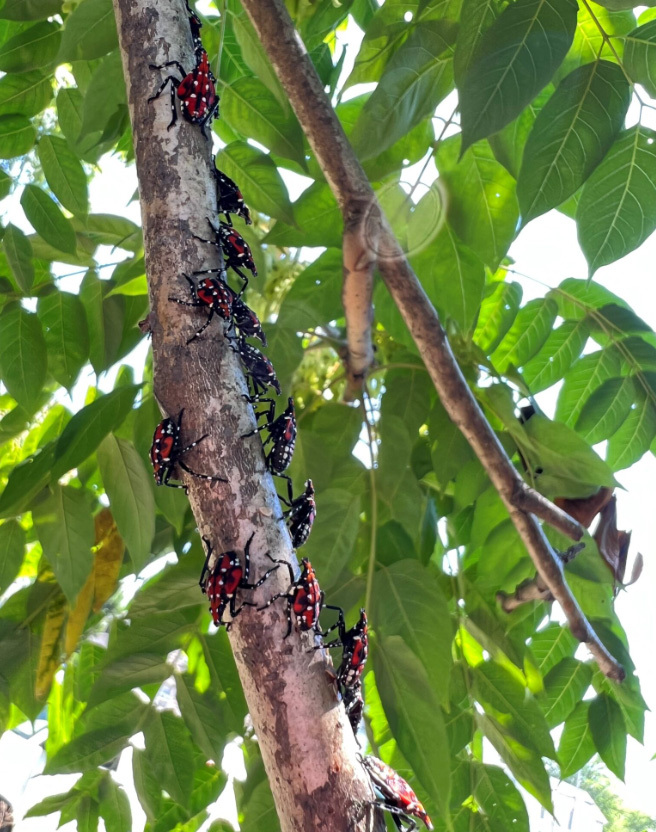It’s Time To Watch For And Report Findings Of Spotted Lanternfly Eggs

An attractive but highly destructive invasive insect is making headway in Indiana, and the Department of Natural Resources seeks help in identifying the insect so that it can work to stop its spread.
Called spotted lanternfly (Lycorma delicatula), the pest is a major concern across most of the United States because of its adverse effect on fruit orchards, nurseries, and the logging and wine industries.
Adults and nymphs of spotted lanternfly (SLF) have piercing-sucking mouthparts and feed on the vascular tissue of leaves, young shoots, branches, and trunks of its hosts. Adults and older nymphs may feed in large populations. This extensive feeding results in oozing wounds on woody tissue and wilting and death of branches.
The lantern part of SLF’s name comes from the inflated portion of its head, which was once thought to be luminous. Its wings are grayish with black spots. Flying displays its hind wings, which are black, white, and red with black spots.
In July 2021, a population of the insect was identified in Switzerland County, near the Ohio River. A second population was found in Huntington last July. The DNR Division of Entomology & Plant Pathology (DEPP) and United States Department of Agriculture (USDA) have been monitoring both sites.
With the insect’s eggs typically hatching in late April, DEPP started scraping egg masses at the infested sites in early February and has destroyed more than 540,000 eggs.
As DEPP and USDA continue to conduct surveys to find the insect’s presence elsewhere in the state, ascertain the extent of current infestations, and determine what other management strategies to implement, Hoosiers are asked to watch for and report sightings of egg masses of SLF in the coming weeks, and for nymphs and adults after that.
Inspection of areas and objects near tree of heaven (Ailanthus altissima), an invasive plant that is common in the Hoosier state, should be a priority because it is the insect’s preferred host tree. SLF typically lays its eggs on smooth surfaces, and eggs may be in sheltered locations or in crevices on trees, rocks, fences, or other outdoor objects, which is part of the challenge of detecting them.
Egg masses are irregularly shaped and about 1 to 1 ½ inches long. The individual eggs resemble wheat kernels strung together in several rows. After laying eggs, the female deposits a protective coating over them that resembles silly putty. As this coating dries and is exposed to the elements it begins to crack and takes on the appearance of dried mud. There can be 30 to 50 eggs in each egg mass.
Nymphs and adults tend to cluster at the base of trees or lower trunk during the day and are more active at dusk or early evening. Infested trees can show significant deposits of honeydew and sooty mold around the base of the tree to the point where the base and surrounding ground may appear black. Tree sap oozing from wounds on trees and the honeydew may attract ants, bees, and wasps.
Hoosiers are also asked to inspect any articles such as logs, firewood, other tree parts, decorative grapevines, any other outdoor household articles, and vehicles coming from Switzerland County, Huntington, or any other area identified as having an infestation.
Immediately report all suspected findings to 866-NO EXOTIC ((866) 663-9684) or DEPP@dnr.IN.gov, providing, at a minimum, the county of the find and contact information so DEPP staff can follow up.
More information is at on.IN.gov/spotted-lanternfly
